
Welcome to our list of the types of ice cream flavors around the world. Everyone around the world has taken a bite off the frozen dessert one way or another. Some of us consume it during the heat waves in our countries while some people would enjoy it even during winter. The ice cream market is competitive because of this. As a result, ice cream nearby your home or office comes up with different varieties to keep people interested.
The inspiration for the types of ice cream comes from different origins. Our goal is to give you a few examples of these ice cream types, what their most popular flavors are, the original way of serving them, fun facts about how they were created, and where you would most likely find them.
There are many possible reasons as to why you would want to know about the different types of ice cream. You could be looking for a new way to serve your ice cream flavors or you just like ice cream so much you like to read all about them. Either way, we got a few examples here for you to go out and check in the real world. Who knows? You might even find your favorite type here!
Origins of Ice Cream
Ice cream was introduced to the world in the 2nd century. Unfortunately, no one truly knows the specific date of its discovery or who invented it. There are accounts of Alexander the Great, King Solomon, and Nero Claudius Caesar enjoying these frozen treats that took many people to prepare.
Marco Polo learned about a dessert similar to sherbert 1,000 years later and introduced it to the Italians. Around the 16th century, England’s nobles were also seen enjoying the treat. Catherine de Medici, an Italian noble, introduced the dessert to her husband Henry II of France. By the year 1660, Procopio Cuto, a Sicilian chef, introduced it to the public through Cafe Procope in France.
By the time it emerged in the United States of America, the technology was advanced enough to be able to sell it to customers every day. It was popular even to President George Washington who consumed over 200 dollars’ worth of ice cream in the summer of 1790 alone. Even to President Thomas Jefferson who created his special recipe with similarities to modern baked Alaska. It was only in the 1800s that it also became a common dessert for middle and lower-class citizens.
Ice cream is now a global sensation. Technological advancements for transportation have created a blend of different types of ice cream. People with different backgrounds have blended well since then. As a result, the influence of two different cultures in dishes has been present in modern ice cream flavors. Every new fusion of ice cream adds growth in ice cream production, generating impressive numbers. In the United States alone, ice cream is produced over 6.4 billion pounds annually.
Types of Ice Cream Around the World
Now that we are aware of its origin, let’s talk about the different types of ice cream around the world. Here we have 16 types with flavors that you should definitely try! So what are we waiting for? Let’s get to the list of the types of ice cream around the world.
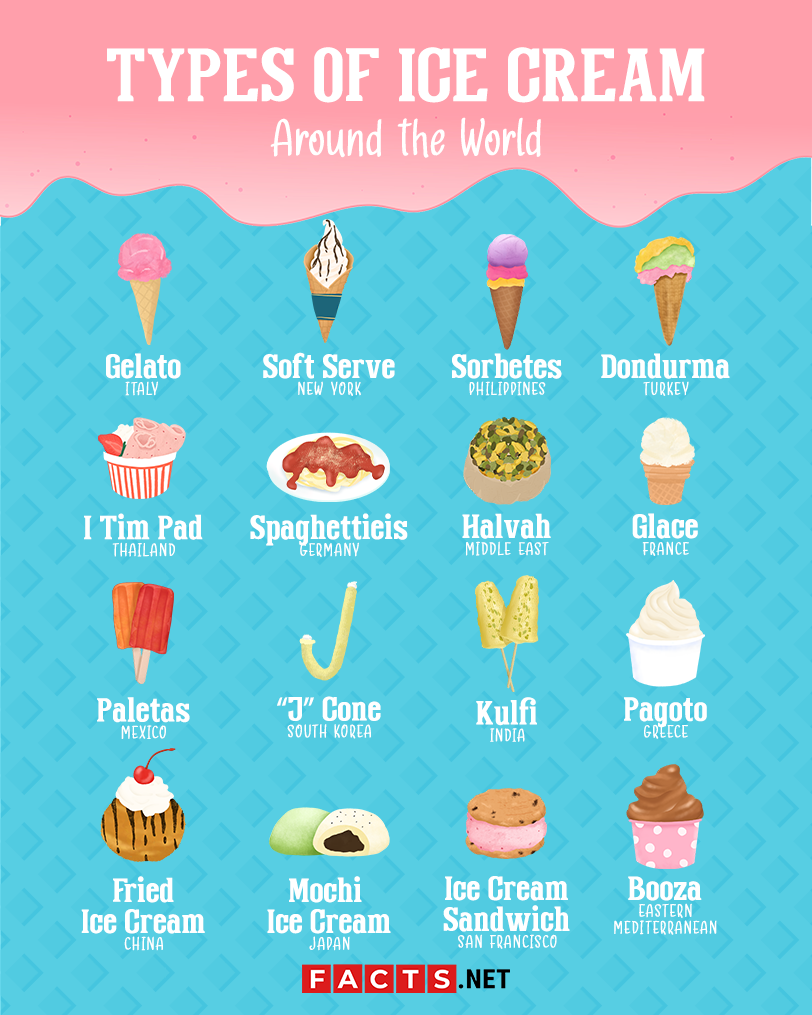
Gelato | Italy
Popular Flavors: Pistacchio, Mandorla, Limone
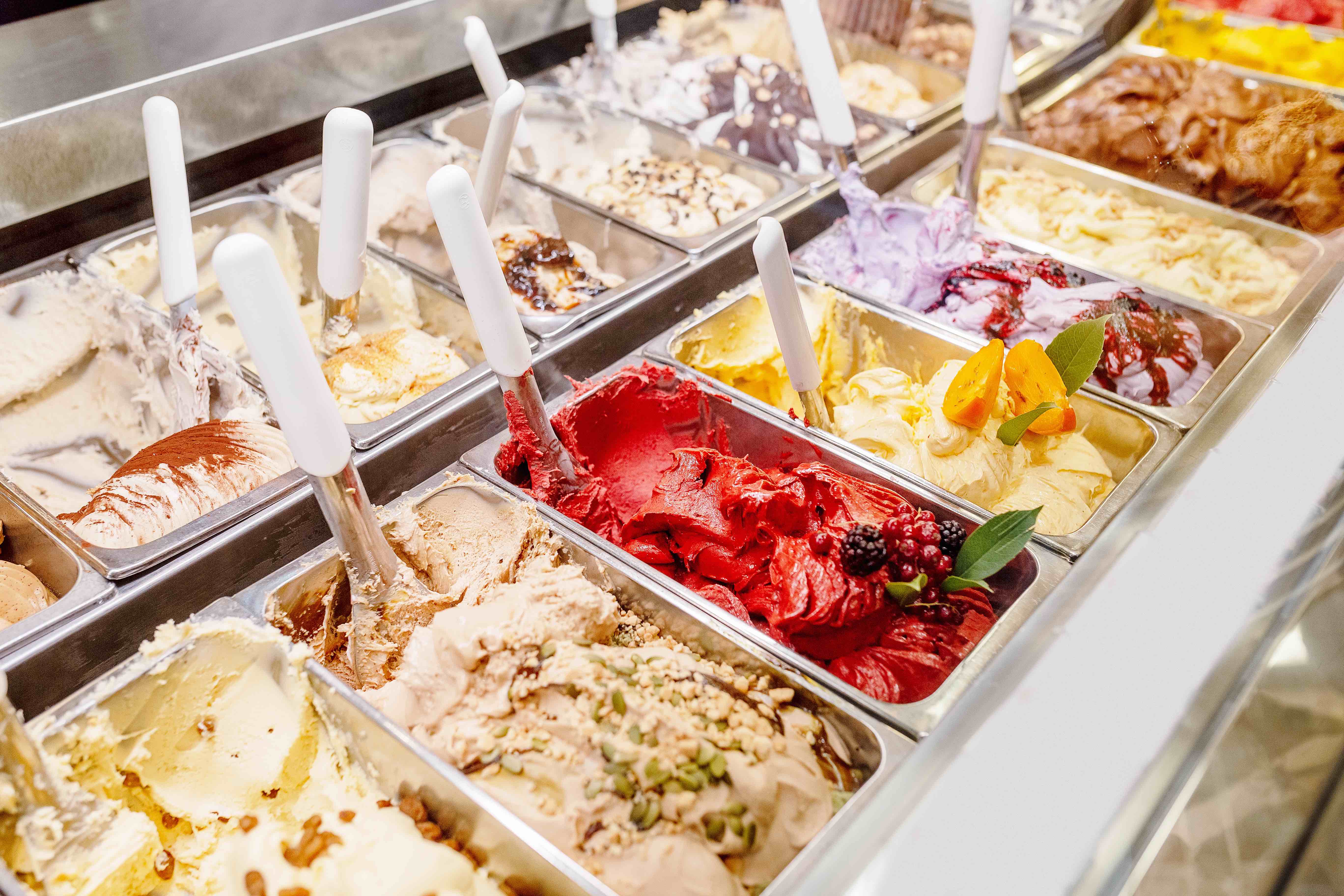
The first one on this list of types of ice cream is gelato. Bernardo Buontalenti, a stage designer, created Italian ice cream in the 16th century. He named it gelato, a direct translation of the word “frozen” in Italian. Catherine De Medici, the queen of France, favored Buontalenti’s dessert. This caused gelato to spread out across Europe. Gelato is made with three main ingredients: whole milk, sugar, and cream.
One difference between gelato and other ice cream types is how it’s stored. Most dessert shops keep their ice cream at negative twenty degrees Fahrenheit or lower. Gelato, on the other hand, is stored between zero to ten degrees Fahrenheit. Ice cream makers churn it at a slow pace to avoid air penetrating the mixture. This allows the dessert to have stronger flavors and a smoother texture compared to other ice creams.
There are two types of gelato stores. The first one is pictured above, with the gelato exceeding the capacity of its tray. These types of gelato stores do this on purpose. They often present colorfully designed gelato to look appealing to customers. The second type of gelato store keeps it covered with a tray. This is to prevent bacteria from latching into the dessert. Choosing which type of gelato store you want depends on whether you prefer to see them displayed or covered.
Mochi Ice Cream | Japan
Popular Flavors: Green Tea, Mango, Chocolate, Strawberries, Red Bean
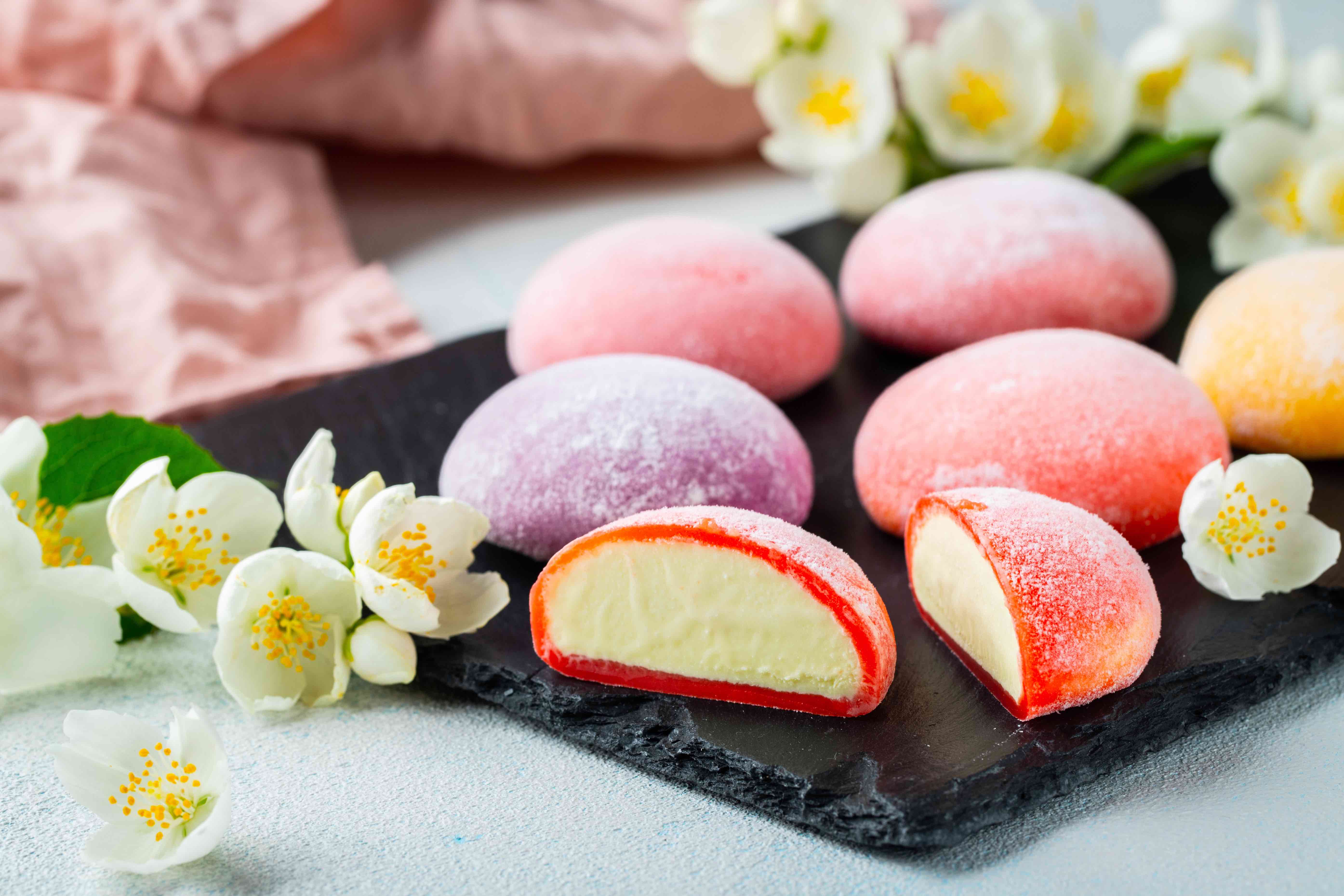
The types of ice cream in Japan are just as delicious as Western ice cream. The Japanese mochi ice cream is a descendant of two types of desserts: Manju and daifuku. The CEO of Mikawaya, Frances Hashimoto, invented the dessert in the 1980s. The idea came to her when her husband began eating small portions of ice cream and wrapping them with mochi. Hashimoto then modified parts of the mochi and the ice cream to accommodate both. She then sold it to the public starting with seven flavors.
Mikawaya debuted the mochi ice cream in the United States in 1993. The process took a decade of dedicated microbiologists and construction experts to achieve a solution for bacteria and pasteurization. It became popular in Hawaii, causing an influx of sales by 1994. The ice cream saw a resurgence in popularity in 2021 when a viral TikTok video discussing the dessert gained 300 million views.
Mochi ice cream tastes milky because of the mochi and is soft enough to chew comfortably. Mikawaya currently has green tea, matcha, black sesame, red bean, plum, strawberry, mango, vanilla, chocolate, mint chip, cookies’ n’ cream, and island coffee flavors. However, other brands like Tesco and My Mochi also offer different flavors of mochi ice cream.
Glace | France
Popular Flavors: French Vanilla, Chocolate, Caramel Fleur de Sel

Next on our list of types of ice cream is a French ice cream called Glace. The French refer to glace as the “classic ice cream.” You can create glace using egg custards, cream, gelatin, sugar, and milk. As it contains large quantities of cream, it is heavier and creamier compared to other ice cream recipes. Glace also uses eggs which give a thick custard texture. It can be served on a goblet, packaged in tinfoil, or even on a cone.
Henry II and Catherine De Medici’s marriage allowed France to learn about ice cream. The first glace recipe was written down in 1674 by Nicholas Lemery. You can find it in Lemery’s book: Recueil de curiositez rares et nouvelles de plus admirable effets de la nature. Recueil de curiositéz rares et nouvelles de plus admirables effets de la nature.
There are four main types of glace ice cream. The French strictly follow the necessary steps to create each one. The first one is creme glacee, which is a direct translation of the words ice cream. Creme glacee requires fresh cream to be created. Glace fermiere is another type of glace. Compared to creme glacee, glace fermiere must be made by farmers specifically.
The third type of glace is glace artisanale. Artisanal glace created without the use of industrial products and ready-use products. The final type of glace is glace vegetale. Vegans are the target market for this type because it uses only vegetable fats and milk.
“J” Cone | South Korea
Popular Flavors: Chocolate, Vanilla, Strawberry, Orange
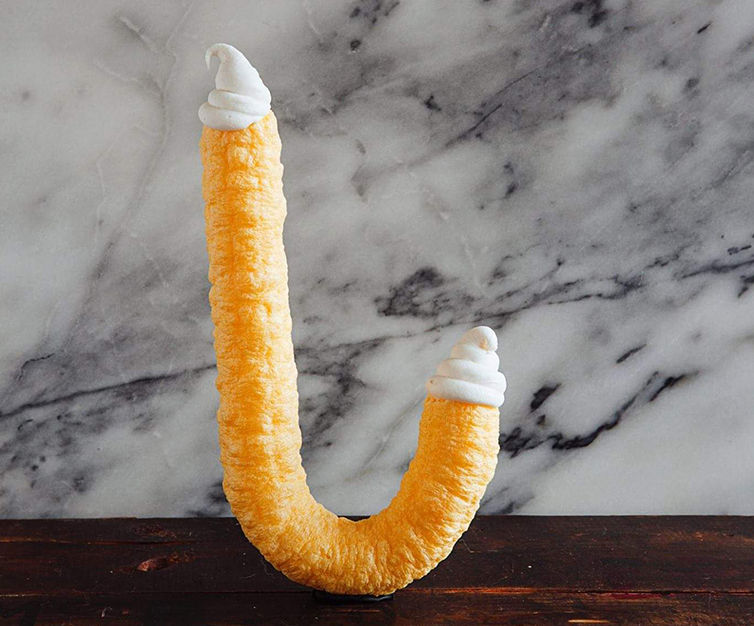
By now, you’d have realized the different types of ice cream are wide in variety. But South Korea’s Jipangyi takes the usual ice cream up a notch with a strange cone shape. Jipangyi cone originated from Insadong, South Korea, and is inspired by the original jipangyi, a traditional Korean corn snack.
Ice cream cones with unique shapes are great. But how do you eat them? Jay Ong, the inventor of the treat, injected soft-serve ice cream inside the corn during its creation. With each end of the cone topped with ice cream, people can eat either part first.
People say the jipangyi cone tastes crispy and bland, but they have health benefits. This is because the cones are made of puff rice and corn, ingredients that support the immune system and reduce cholesterol levels.
Today, the ice cream can be found worldwide thanks to franchising. Ryan Bang, a South Korean celebrity popular in the Philippines, introduced jipangyi to Filipinos in 2014. The kooky ice cream can now be ordered from 45 branches around the country.
Dondurma | Turkey
Popular Flavors: Plain, Pistachio, Cocoa

Turkey’s dondurma is the next on our types of ice cream. Dondurma is also known as “Maras ice cream.” This is because dondurma was first invented in the city of Maras. It includes cream, whipped cream, sugar, mastic, and salep.
Mastic is a unique ingredient of dondurma. It is made from mastic trees from Chios island. Salep is also another special ingredient. It is made from tuberous roots of orchids. Unfortunately, few legal saleps are being sold outside of Turkey. This is because the orchids are endangered due to habitat loss. As a result, authentic dondurma may be difficult to find in other countries.
People who have consumed dondurma say that it tastes like pine due to its strong aromatic smell. Mastic resin causes the sweet flavor by melting into the ice cream and also creates the thickened texture. Dondurma is also slow to melt. This is because of the salep, which is combined with the mastic, that retains the ice cream’s moisture.
You can find street vendors and storefronts selling dondurma around Turkey. They are easy to spot as they are usually wearing Ottoman period clothing. Dondurma vendors also tease their customers as part of the presentation. The vendors will repeatedly act like they are handing the ice cream to the customer, only to take it back with different tricks and movements.
Spaghettieis | Germany
Popular Flavors: Vanilla, Strawberry, Chocolate
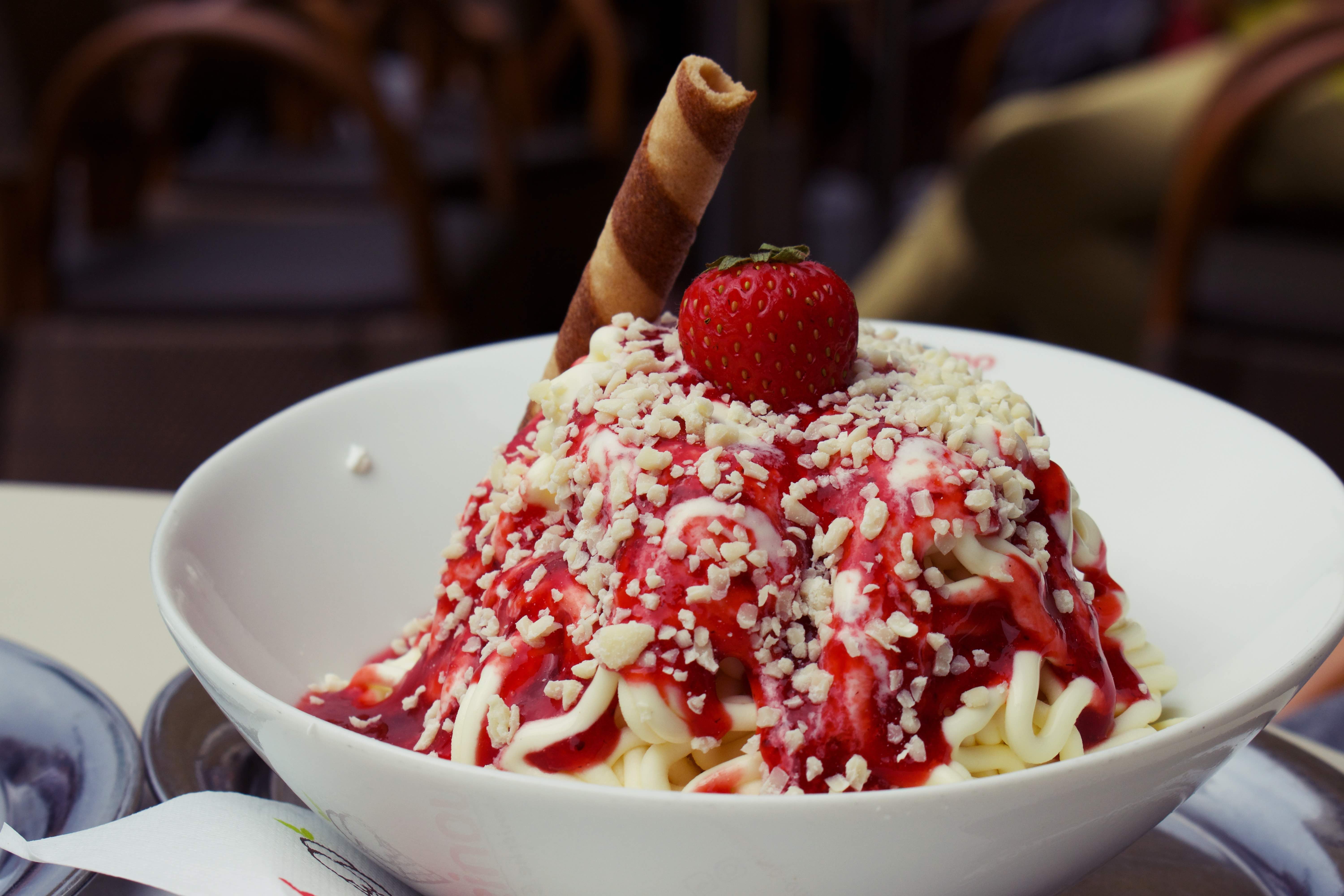
Spaghettieis is a type of ice cream that originated from Mannheim, Germany. Dario Fontanella created the ice cream recipe for his children in the 1960s and was intended to look similar to a plate of spaghetti. For decades, spaghettieis was hidden outside of Germany and was only served during special occasions and a few ice cream parlors. However, it has recently gained a reputation in social media. The city of Mannheim awarded Fontanella in 2014 with the highest civilian achievement, the “Bloomaulorden”, for the spaghettieis.
To create spaghettieis, you will need a Spatzle press or a potato ricer that you need to create the noodle-looking ice cream. The traditional recipe uses vanilla ice cream for the noodles and strawberry syrup for the tomato sauce. Grated almonds, white chocolate, or coconut flakes are sprinkled on top of the ice cream as a substitute for parmesan cheese.
Today, spaghettieis can be served with chocolate and strawberry as noodles. Different stores offer a wide variety of syrups as well. Dolce Gelatteria in New York offers blueberry, raspberry, mango, and peach syrups.
Halvah | Middle East
Popular Flavors: Sesame, Sunflower, Silan (Date Syrup)

Halvah ice cream is a famous type of ice cream in the Middle East. It is made up of eggs, sugar, cream, halva, and is topped with different types of nuts. All you need to do is pour the halvah onto a vanilla base to create the ice cream. You can find authentic halvah in Israel, Lebanon, Iran, Turkey, and India.
Jewish people have been consuming halvah for over two millennia. After being nomads, the Jewish had to adapt to different cuisines. In these cuisines, the halvah is included. Indian merchants traded with the Jewish people, who then remade halvah into their own recipe. The different varieties of recipes for halvah have also created five main types of halvah as a result.
The first type of halvah is the grain-based halvah. The Indians and the Turkish created this type of halvah with flour. The second type is made up of sesame, which became popular in the Balkans, the Middle East, and Poland. This is also the type of halvah preferred in making halvah ice cream. The sunflower halvah uses large amounts of sunflowers as a substitute for sesame seeds.
Argentina created its own type of halvah out of peanuts. They came from Greeks who immigrated into the country. The Greeks rebranded it as mantecol or nucrem. Turkey created the floss halvah. This is made up of thin strands of halvah. These types of halvah are also a reflection of the flavors in which halvah ice cream is made up of.
Kulfi | India
Popular Flavors: Rosewater, Pistachio, Saffron

The difference between other types of ice cream and kulfi is the way it is prepared. Most ice cream recipes freeze the contents altogether. However, kulfi is created by boiling the ingredients and then freezing them. Kulfi has also been proven to be healthier than conventional ice cream. This is because kulfi’s ingredients do not use preservatives or eggs. Kulfi also does not require air additives.
The word kulfi comes from the Persian word qulfi which means “covered cup.” Researchers speculate it came from the Mughal Empire, an empire that existed in South Asia. You should be careful not to confuse it with kulfa, which has the same ingredients but is served on a platter rather than a stick. The city of Rawalpindi in Pakistan is famous for kulfi, where there is an estimated 1,000 servings of ice cream per shop.
You can make kulfi with boiled milk, demerara sugar, salt, saffron, and pistachios. It is considered a no-cook recipe, making it simple enough to be made quickly. There is a wide variety of flavors for kulfi. Most notably are pistachio, saffron, cardamom, almond, and cashew. There also are the more adventurous flavors such as lychee, mango, and paan (betel leaf, betel nut, and slaked lime.)
Pagoto | Greece
Popular Flavors: Nutella Banana with Strawberries, Pavlova Gelato, Passionfruit Sauce with Meringue
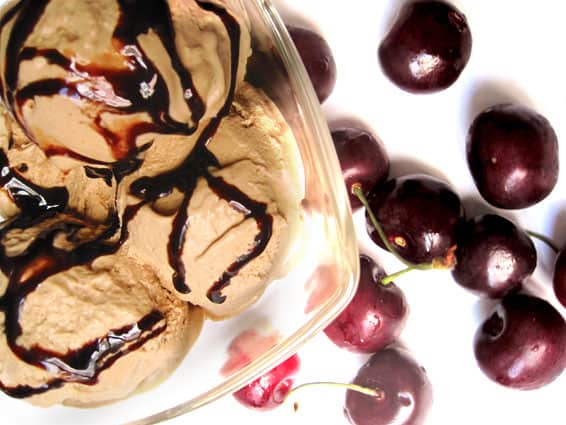
The pagoto represents the Greeks in this list of types of ice cream. The Greeks developed it around the same time ice cream was beginning for Europe in the 20th century. Ancient Greeks had long been consuming frozen desserts even before pagotos invention.
Alexander the Great enjoyed frozen treats with honey and nectar in the 4th century BC. It became more accessible to the public a century later. The Ancient Greeks of the 5th century BC consumed snow with honey and fruit. They could purchase the dessert in Athenian markets. Hippocrates, the father of modern medicine, believed it energized lifejuices and was good for a patient’s health
Evidence of Turkish influence with the Greeks can be seen in pagoto. In fact, pagoto was once called dudurmas. Since then Turkish and Greek relations have soured, resulting in the Greeks changing the name. Pagoto uses olive oil, figs, cocoa, filo dough (texture similar to angel’s hair pasta), and mavrodaphne (Greek dessert wine) to create flavors of their ice cream. Toppings such as pistachio nuts and sour cherry preserves can also accompany your pagoto dessert. Included in the toppings are Greek-made jams and syrups to make it sweeter.
Modern pagoto has now 200 different flavors. The most popular flavors cater to sweet tooths. Baklava, diples, and kataifi are traditional Greek desserts with pagoto flavors. You can also find modern pagoto flavors such as cookies and cream, chocolate, and strawberries.
I Tim Pad | Thailand
Popular Flavors: Vanilla, Matcha, Strawberry
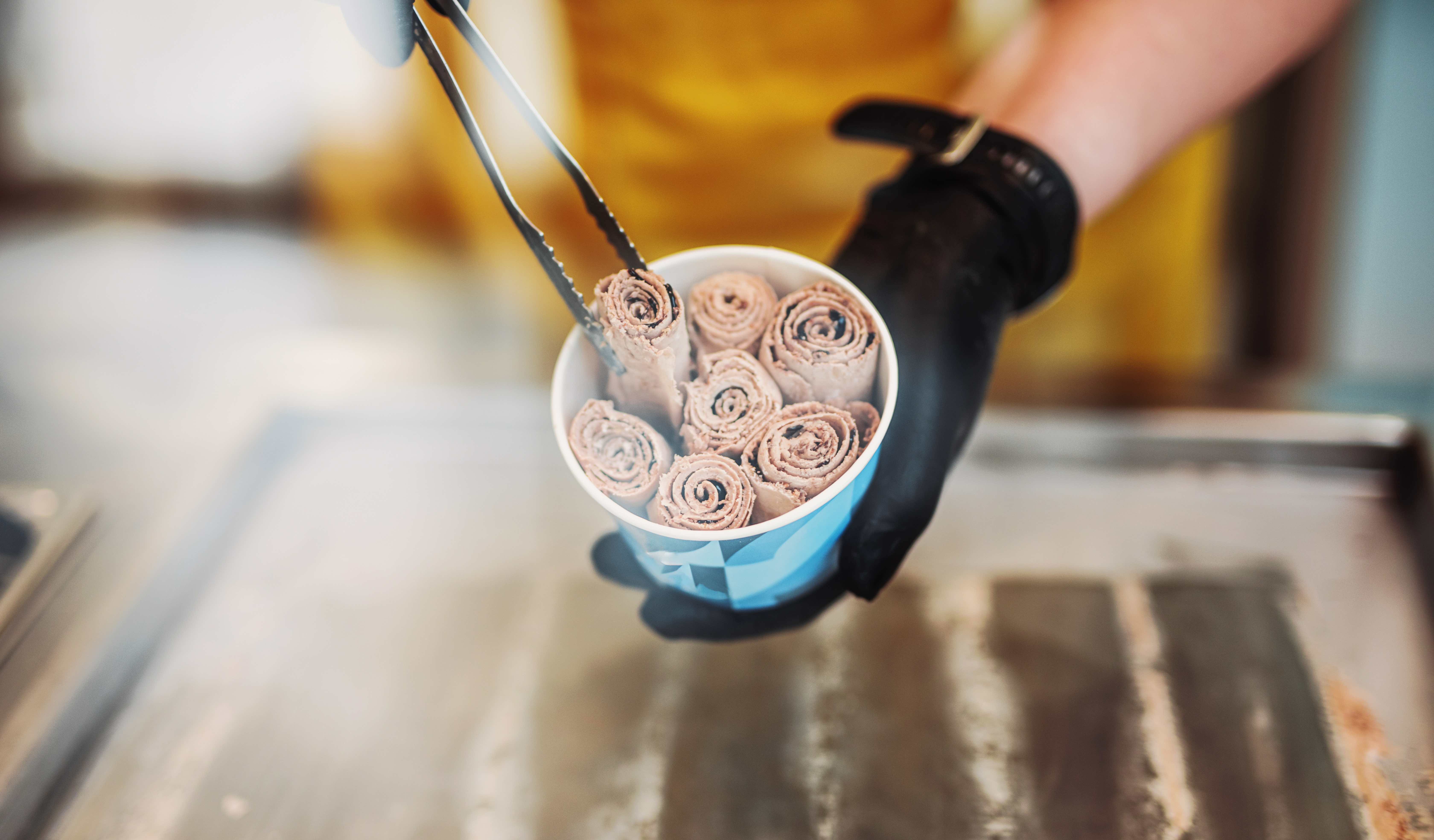
Of the types of ice cream listed here, I Tim Pad originating from Thailand has one of the most satisfying presentations. It is mixed thoroughly on an ice pad to incorporate air before rolling and placing it on a cup. The final results show vertical rolls of the ice cream organized and placed beside each other. This is also the reason why I Tim Pad is also known as rolled ice cream or stir-fried ice cream.
The citizens of Thailand invented I Tim Pad in 2009. In 2015, the rolled ice cream trend started gaining popularity in the West. You can create I Tim Pad with a mixture of milk with flavors and fruits of your choice. With two handles, the vendor chops and mixes the ice cream on an ice pad for a few minutes. People describe it as similar to kneading. Vendors then add toppings carefully to the rolled ice cream in the cup.
Fried Ice Cream | China
Popular Flavors: Green Tea, Vanilla, Taro

Fried ice cream is a type of ice cream that originated in China in 3000 B.C. First introduced to the West through The Chicago World’s Fair of 1893, there are claims that the Japanese introduced the fried ice cream first, using tempura batter instead. The conflicting reports make it difficult to pinpoint when the modern fried ice cream recipe was truly invented.
You can easily make fried ice cream. All you would have to do is take a scoop of frozen solid ice cream, coat it or bead it in batter, and then deep fry it quickly. This produces a crispy but soft shell around the ice cream similar to an ice cream sandwich. Fried ice cream comes in different flavors since they are mixed with the batter pre-made. The most popular, however, is vanilla. You can coat your fried ice cream with chocolate, strawberry, or caramel syrup. There is also the option of placing fresh fruits and other toppings with it.
According to the Food Network, the best fried ice cream in the world is found in Frach’s Fried Ice Cream, an ice cream shop in Los Angeles. They use tempura batter, caramel syrup, and assorted cookies and cornflakes to complete their sought-after dessert.
Sorbetes | Philippines
Popular Flavors: Cheese, Cookies and Cream, Mango, Chocolate
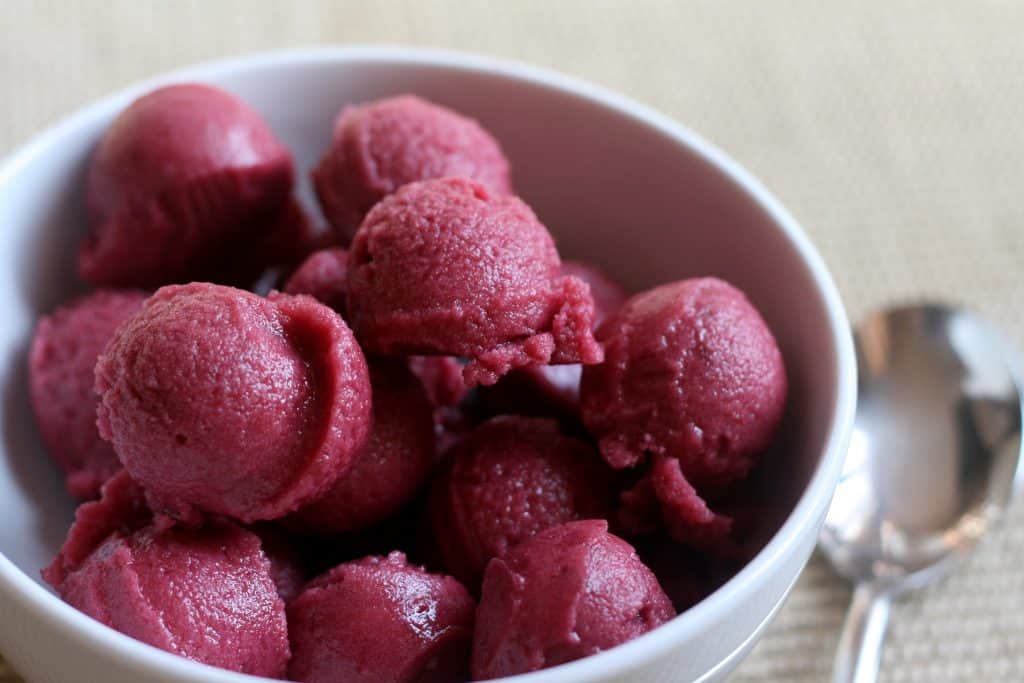
The Filipinos enjoy their own type of ice cream called sorbetes. Invented during the American occupation in the Philippines, you will find two unique things about sorbetes. The first one is how it is sold and the second one is the type of milk used to make it.
Sorbeteros sell sorbetes. They use portable ice cream carts and travel around the area with bells to alert potential customers. The sorbeteros also design their carts differently. They are usually colorful with three or four ice cream flavors available. On sunny days, the cart has an umbrella attached to it to protect the sorbeteros and their customers from extreme heat. Sorbeteros sell their sorbetes with different sizes of cake cones, pandesals (to create ice cream sandwiches with), or small plastic cups with wooden spoons.
The milk used when creating sorbetes is not your traditional cow’s milk. Filipinos created sorbetes with the use of carabao’s milk or coconut milk as a substitute. It is sweeter, thicker, and melts quicker than soft-serve ice cream. Sorbetes flavors such as ube, queso, mango, and chocolate are common. Unique flavors such as avocado, melon, and jackfruit are also available.
People have attached a negative term on sorbetes. Some people call sorbetes “dirty ice cream”. Making and storing sorbetes, however, is usually done cleanly and safely.
Paletas | Mexico
Popular Flavors: Pineapple, Coconut, Passionfruit

Paleta is a type of ice cream found in Mexico. Modern paletas are created with the use of fruits such as mango, and strawberry, but can also be made with Sicilian pistachio or chocolate. Paletas are also composed of water, condensed milk, and milk. People who have consumed paletas describe it to be aromatic with chunks of fruits and vegetables inside. Traditional paletas had mango, cucumber, lime juice, and tamarind blended together.
Making paletas is simple. You only need to have all the ingredients blended and placed inside a mold to freeze. However, the ingredients need to be completely natural and fresh. Compared to the American popsicle, paletas are healthier. While American popsicles are consistently one texture and one flavor, paletas constantly change with each bit.
The word paletas is Spanish for “little stick.” The civilians of Tocumbo, Mexico created the recipe for paletas in the 1940s. The families of Tocumbo then created paleterias to produce more paletas for their growing number of customers.
Soft Serve | New York
Popular Flavors: Black Cherry, Earl Grey Ice Cream, French Vanilla

Arguably the most popular type of ice cream is New York’s soft serve. Vendors usually put this ice cream in cones such as the cake cone, the sugar cone, and the waffle cone. The sugar cone vs waffle cone debate may confuse you, but the only difference between the two is that the sugar cone is perfect for slow eaters.
It was Charles Taylor of Buffalo who patented soft-serve ice cream machines in 1926. However, it was Tom Carvel who perfected the soft-serve ice cream recipe. In 1936, Carvel’s flat tire inspired him. Carvel created the soft-serve ice cream after selling his melting ice cream on the spot. But the most well-known company that created their own version of soft-serve ice cream is Dairy Queen.
JF McCullough and his son Alex, founders of Dairy Queen, invented their own recipe in 1938. They held a trial sale at their friend’s local ice cream shop. The results showed that over 1,600 customers requested their soft-serve ice cream.
Since the invention of soft-serve ice cream machines, the ice cream has become easily accessible worldwide. Its ingredients are also readily available. Ingredients of a traditional soft-serve comprise cream, milk solids, stabilizers, preheated and frozen milk, emulsifiers, and different flavorings.
Ice Cream Sandwich | San Francisco
Popular Flavors: Neapolitan, Vanilla, Chocolate Chip
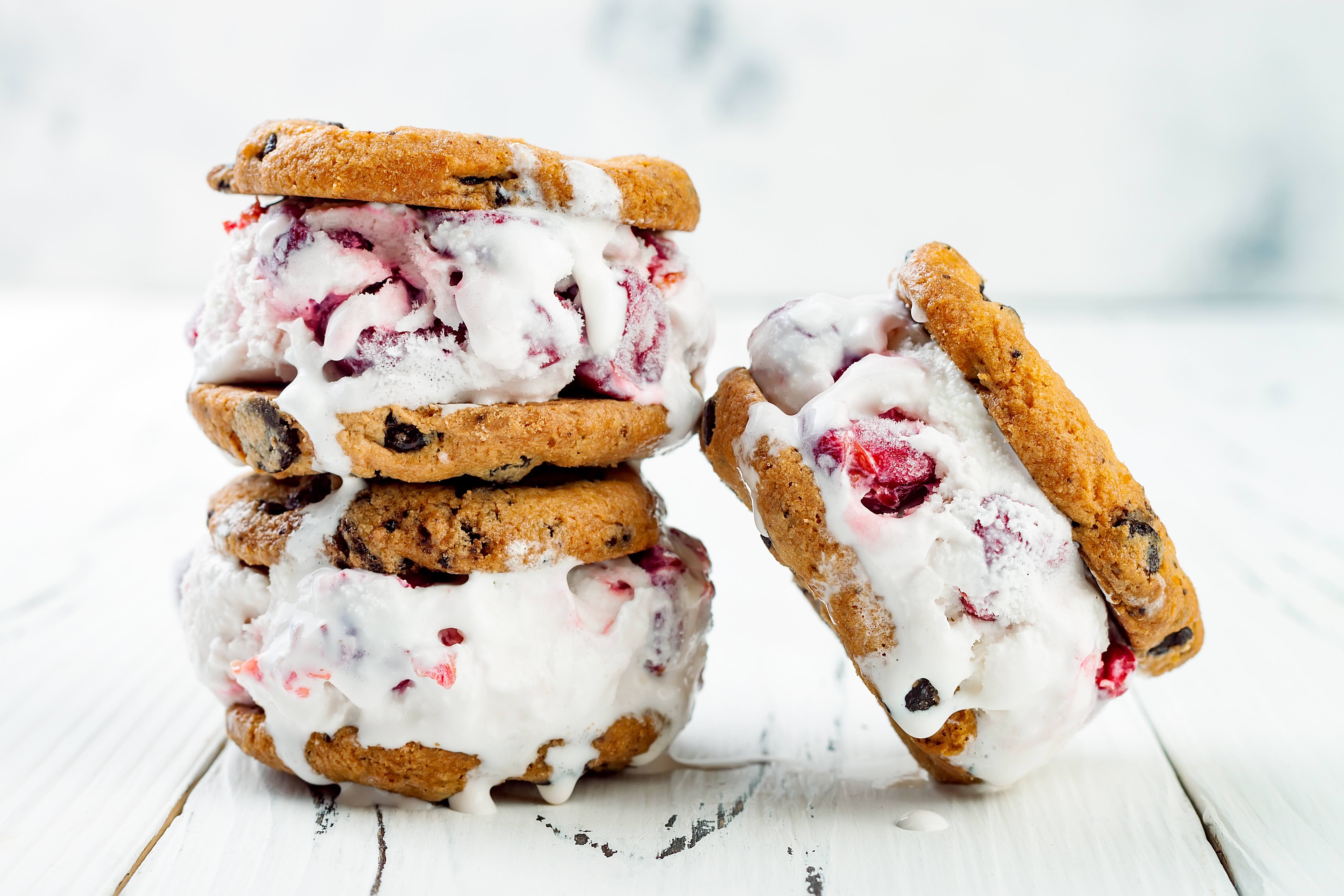
San Francisco is known as the birthplace of It’s It Ice Cream, a century-old ice cream shop. What’s so great about this ice cream shop? They created the now universally-loved ice cream sandwich. In 1928, the ice cream vendor George Whitney of San Francisco decided to place two oatmeal cookies between a scoop of ice cream and dipped them into dark chocolate.
Contrary to popular belief, the ice cream sandwich doesn’t necessarily use wafers. A popular type is the ice cream sandwich cone, which has the entire wafer filled with ice cream.
Some countries have given the ice cream sandwich its own twist. The Philippines uses the pandesal, a soft bread roll. Iran’s bastani-e nooni is also a type of ice cream sandwich made by placing saffron and rosewater ice cream in between wafers and coating it with pistachios.
Nowadays, you can easily purchase ice cream sandwiches. They are found in malls and even small dessert shops. Industrial giants such as Dairy Queen and Klondike have mass-produced ice cream sandwiches internationally.
Booza | Eastern Mediterranean
Popular Flavors: Salted Caramel, Ashta, Hazelnut
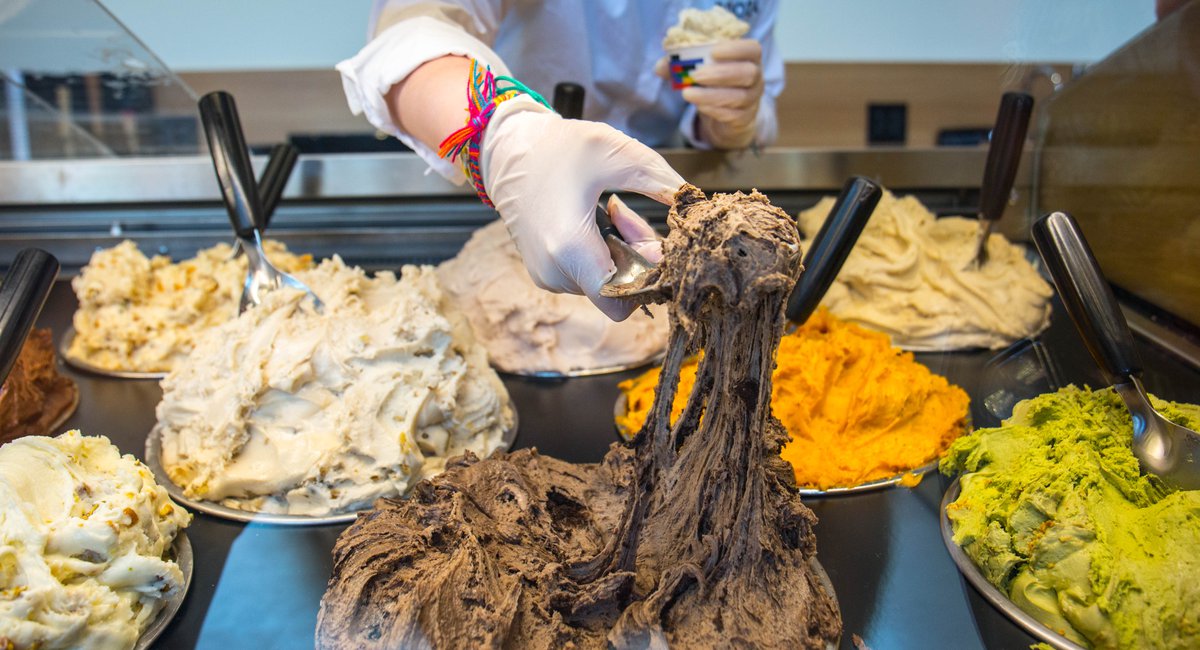
Last on the list of our types of ice cream is booza ice cream from Eastern Mediterranean cultures. Booza, also known as the stretchy ice cream of Syria, consists of salep and mastic. This makes it similar to dondurma. The difference between dondurma and booza is how it is made. Booza vendors use freezer drums, a rotating compact machine used to prevent air from infiltrating the product, to stretch and pound the ice cream. Bakdash is an ice cream store in the Old City of Damascus found in Al-Hamidiyah Souq. Arabs from all around the world gather to get a taste of their own stretchy and chewy ice cream.
You can find two international branches of booza ice cream in the world. The first one is in Australia. Jilbert El-Zmetr and Tedy Altree-Williams are siblings who invented the first packaged booza for Australians. They established their company in 2011. Their mastic and salep are sourced in Chios, Greece specifically. You can find the second shop in Williamson, Brooklyn. Store owners Tamer Rabbani and Michael Sadler named it Republic of Booza.
Booza is commonly topped with nuts like pistachios, but can also be enjoyed without any toppings.
Conclusion
Which of the types of ice cream did you find most interesting? The different ways to enjoy ice cream reflect its country of origin. And since ice cream recipes are available to anyone, why not try learning one on your own? There is always room for more flavors of ice cream and even more creative ways to fuse one type with another. After making your version of ice cream, don’t forget to share them with your loved ones. After all, food tastes better when shared!
Was this page helpful?
Our commitment to delivering trustworthy and engaging content is at the heart of what we do. Each fact on our site is contributed by real users like you, bringing a wealth of diverse insights and information. To ensure the highest standards of accuracy and reliability, our dedicated editors meticulously review each submission. This process guarantees that the facts we share are not only fascinating but also credible. Trust in our commitment to quality and authenticity as you explore and learn with us.


